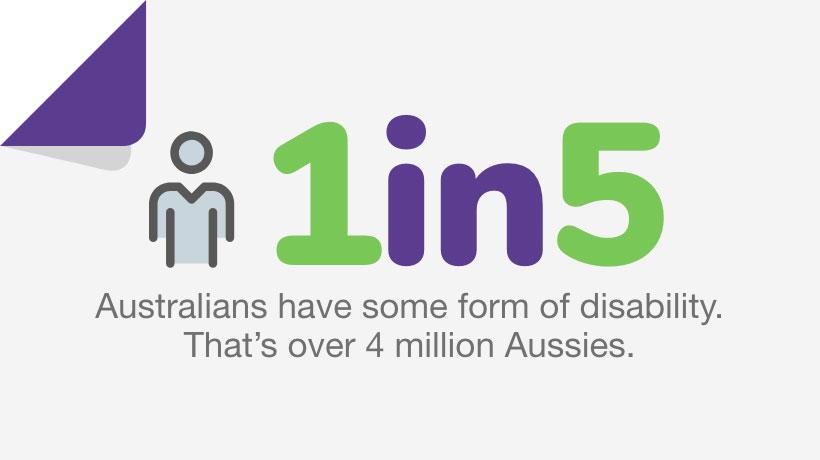Assistive technology for physical disabilities: what you need to know as a NDIS Participant
Thursday, May 16, 2019
Many diseases and disorders can unfortunately leave people disabled and physically impaired. Some of these impairments can be permanent and Assistive Technology (or AT, as it is commonly known) help people cope with their physical disabilities.
Today’s assistive technologies have seen impactful changes over the last few decades making AT solutions far more comprehensive.
What is Assistive Technology?
Assistive technology for physical disabilities is any device, system or design created to help people perform tasks that may be extremely difficult or impossible to do on their own. AT helps people maintain greater independence by making tasks easier and safer, regardless of their disability.
Yet, more people benefit from AT than you might think. The surprising truth is that most people use some form of assistive technology in their daily lives. That’s because AT benefits more than just the individual user. It helps those who care for disabled people, too.
According to the Australian Bureau of Statistic in 2015, almost one in five Australians have a disability or functional limitation. It’s clear that AT is common in our communities and everyday

Different Types of Assistive Technology
Some common types of AT might include:
- Mobility aids, such as wheelchairs and canes
- Closed captioning for those with hearing loss
- Cognitive aids like computer devices to assist with memory, attention or other thinking challenges
Like many technologies, AT ranges from really simple to incredibly complex. From ramps in public areas and special keyboards in the education field, there are so many variations of AT available.
You may need help figuring out what the right AT solution is for you. Depending on the cost and complexity, participants may follow different processes, which we will touch on shortly.
AT can be included in your NDIS plan if the NDIA believes it to be a reasonable and necessary support that will meet your needs and help you achieve your goals.
Firstly, it is important to note which assistive technology will not be funded by the NDIS:
The NDIS will not fund items that are more appropriately funded by another body or agency (for example, the health sector).
These include, but are not limited to:
- Treatment or rehabilitation items (including therapy aids not used at home);
- A public-built environment (for example, footpaths, ramps and lifts);
- Mainstream technology, like a car, which doesn't overcome functional limitation - however modifications to the car could be funded as AT (for example, including a steering wheel device to help a participant steer, or a lift in the rear of the vehicle to accommodate a wheelchair);
- Items and activities not including a device (for example, medicines or training).
Assistive Technology Complexity Levels Explained
The NDIS use four levels to describe the complexity of your AT needs.
If you have any doubts about which of the categories your item falls into, it is a good idea to check with your support coordinator, LAC or planner, or Occupational Therapist before moving forward with purchasing.
Level 1 – Simple, low-risk AT
This level describes simple, low risk AT products and services that are easy to buy and need no or very little assistance to set up and use.
Examples:
- Non-slip bathmat
- Large print labels
- Doorbells
These are everyday AT items that you can easily access and test out that don't cost much or require support. You can choose to buy these from everyday suppliers like your local hardware store or pharmacy that are NDIS registered or from suppliers you find on the internet when you are plan-managed.
Level 2 – Standard AT
AT you can buy easily "off the shelf", test and trial before making a final choice. However, you might need help to set up AT at this level.
Examples:
- Bath seat
- Hand rails
- Ramps
Depending on availability and your individual circumstances, you may require an assessment but you can typically find this type of assistive technology from an AT supplier.
Level 2 – Standard AT
AT you can buy easily "off the shelf", test and trial before making a final choice. However, you might need help to set up AT at this level.
Examples:
- Bath seat
- Hand rails
- Ramps
Depending on availability and your individual circumstances, you may require an assessment but you can typically find this type of assistive technology from an AT supplier.
How Your NDIS Plan is Managed
Now that you know which AT falls into which complexity category, it’s important to know how your NDIS plan managed. Your plan can be managed in three ways.
1. Self-management
If you self-manage your AT budget, you can choose and negotiate directly with a supplier to get the best value for your money that’s in line with your goals and budget. Your equipment provider may or may not be registered with the NDIA. You do not need a service booking for your self-managed AT support since you pay your providers directly.
2. Plan-management
If a Registered Plan Management Provider (RPMP) is managing your AT budget, your RPMP will support you to engage with the NDIS Registered providers of your choice. They will also help you create service agreements and issue service bookings. In this scenario, the RPMP pays your providers on your behalf.
3. NDIA-managed
If the NDIA is managing your NDIS plan, your Local Area Coordinator (LAC) or Support Coordinator (if one is funded in your plan) will support you to engage with the NDIS Registered providers of your choice, and they will help you create service agreements and issue service bookings. In this scenario, the NDIS pay providers on your behalf.
Maintenance and Repairs
Participants should check who has responsibility for the maintenance and repair of their assistive technology.
Generally, if you lease or hire an item, the organisation who provided it would help fix it, or if necessary, replace it. If the item has been bought outright, Australian Consumer Law gives you warranty rights on the supplier if something is wrong with the item.
Discuss any current assistive technology you have at your plan review meeting or initial planning meeting as you can then negotiate with LAC or planner as to what is need to be repaired or maintained for that particular plan period and it may be granted in your plan funding.
However do keep in mind the NDIS does not own a participants equipment/AT and it does not have an equipment repair service like some state ad territory equipment/AT schemes. It is rather a needs-based funding given participants on an individual basis.
Its also useful to know that You can opt to use your own money, or funding from other sources (for example, Job Access) to buy additional features, or access additional services which may not fall under reasonable and necessary supports in your NDIS plan. For example, a participant funded for a fabric-upholstered lift chair may prefer leather upholstery. In this scenario, the participant pays any additional cost to have the chair upholstered in leather.
Equipment/AT Questions
As always, feel free to discuss with your support coordination team. If you don’t have one, you can utilise your local area coordinator or NDIS planner. You can find the email for your regional office and send them any equipment/AT questions, or utilise the quickest method to get a clarity on a query- call NDIS helpline directly on 1800 800 110.
To get in touch with the Marli & Moe NDIS Support Coordination team today just give us a call on 1300 797 454 or on the email [email protected]
Recent Posts
- 🌸 Mindfulness and Journalling 🌸
- 🎭 Drama Blog: We’re Going on a Bear Hunt 🐻✨
- Origami 🌀
- Big Chop Energy 💇🏼♀️✨
- Real Talk, Real Tears, Real Growth 💖
- When Life Hits You (Literally) – My Ankle Drama 🦶💥
- ✨My Marli Day at the Easter Show 🐣🎡✨
- My First Iftar Dinner 🌙🍽️
- Harmony Day at School – Laming-Town Stall
- Hearing Aids

